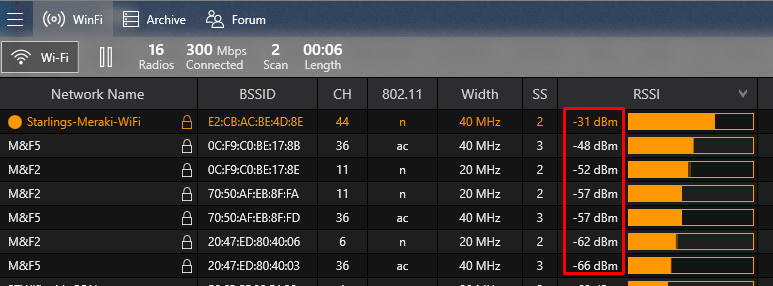
Hey!
Welcome to our latest blog – this time we are taking it back to some RF fundamentals and more specific – RF Math!
Since we started our Podcast & Blog, we have had requests from people to cover beginner level WiFi basics, which we will be doing with a series of blogs & podcasts coming up in the future but today let’s make a start with understanding some RF Maths.
You might be wondering why do I need to learn RF maths? I had enough of Maths when I was at school – I don’t want to have to do it all again! Well RF maths is important in WiFi because we typically measure WiFi in dBm & dBm means dB scale relative to mW. For example, when looking at your RSSI (Received Signal Strength Indicator) in dBm it would look something like this “-50dBm”.

Now I am no maths expert at all, so luckily there is a relatively simple rule we can follow to pretty much work out all RF maths.
This is the rule of “10s & 3s”
Below is a table, on one side we have dBm and on the other we have mW. Now whatever we do on one side of the table we must do on the other side of the table. If you + (add) in dBs, then we X (times) in mW. If we – (minus) in dBs, then we / (divide) in mW. 10 in dBs is 10 in mW and the only thing that is a little bit tricky to remember is 3 in dBs is 2 in mW.
| dBm | mW |
| + | X |
| – | / |
| 10 | 10 |
| 3 | 2 |
This table below might help paint a bit of clearer picture, for example if we increase the signal strength by +3dBs we then have 2 x the power. If our signal strength decreases by -10dBs we then have 1/10th of the power that we had.
| dBm | Power |
| +3dB | 2x Power |
| -3dB | ½ Power |
| -10dB | 1/10th Power |
| +10dB | 10x Power |
Starting to make a bit of sense? If not, do not worry as we have plenty more examples below that will help you have a better understanding of how this works & we have even thrown in a little quiz for you guys!
When we are doing RF math, we always start with 0dBm & 1mW at our starting point.
In the example below, we are converting dBm to mW & our aim is to work out what 13dBm would be in mW.
Remembering that we always start from 0dBm, we first would add +10db and then add another +3dBs to get to 13dBm. Now to convert that to mW & remembering that we always start from 1mW, we first x 10 and then x 2. Which would mean our calculation would be “1 x 10 x 2” and then equals 20mW.

Let’s move on to another example. This time, how do we convert 36dBm into mW. See in the image below, in dB we +10 +10 +10 +3 +3 to get to 36 so that means in mW we x10 x10 x10 x2 x2 which = 4000mW.

A very strong signal in WiFi & typically the highest you will see is -30dBm. Let’s work out in mW what is considered a very high RSSI if WiFi. Remember we start from 0dBm, so -10 -10 -10 will get us to -30dBm. Which means in mW we / 10 / 10 / 10 – so our calculations will be 1 / 10 / 10 / 10 which equals 0.001mW! Wow, so an extremely good strong signal in WiFi has a power level of 0.001mW?! That’s impressive!

Let’s move on to another example, this time -53dBm (still a very good signal strength in WiFi). To get to -53 from 0 we need to – 10 – 10 – 10 – 10 – 10 – 3. Which in mW would be / 10 / 10 / 10 / 10 / 10 / 2. That means our calculations would 1 / 10 / 10 / 10 / 10 / 10 / 2 which equals 0.000005mW.

Are you starting to see why we do not measure RSSI in mW? Imagine having to go back to the customer and say, “oh yes Mr. Customer your signal strength here is very good, its actually 0.000005mW!” I think being able to say that the RSSI is -53dBm is much easier ????
I have put together another table below of some additional dBm conversions to mW and to Watts for your comparison.

Hopefully after those few conversions we have worked out together you guys are ready for a little quiz & to work out some dBm to mW yourselves! Now, I will put the answers to the dBm levels below at the bottom of the blog but do not cheat! Work these ones out yourself using the 10s & 3s rule as well at the examples above and see what answers you come up with!
Quiz dBm to mW:

Now that we are all RF Math WiFi Ninjas lets take this another step & take into consideration what happens when WiFi passes through walls. Some typical wall type materials we see in the wild & how they attenuate the WiFi signal.
If we first look at what wall is most commonly used internally in buildings, which is “drywall”. On average typically drywall will have an attenuation level of 3dBs. So that means when WiFi signals pass through the drywall we will lose -3dBs & losing -3dBs means that we now have half the power we originally did. Looking at the image below we can see an AP on the left-hand side where client A has an RSSI of -49dBm, but on the other side of the drywall, client B has an RSSI of -52dBm.

Moving on to another type of wall that is commonly used on the exterior of buildings, “brick wall”. A brick wall typically has an attenuation of 10dBs, so this means when WiFi signals pass through a brick wall they will lose -10dBs, therefore we will now have 1/10th of the power we originally had before passing through the brick wall. Looking at the image below we can see an AP on the left-hand side where client A has an RSSI of -49dBm, but on the other side of the brick wall client B has an RSSI of -50dBm.

The final concept that we would like to explain to you is something called “Free Space Path Loss) aka – FSPL. What we need to remember with FSPL is that when you double the distance, you quarter the power. That will mean at double the distance we will need to half the original power and then half it again. To half the power in WiFi, we need to -3dB.
In the example image below, we are using the example of at 1m distance from the AP, we have an RSSI of -30dBm, we then move to 2m distance which is double 1m so we need to quarter the power which means -3 + -3 so at 2m our RSSI should be -36dBm. You can see / work out for yourself how we got to that RSSI at 4m & 8m ????

Here are the calculations and answers to the quiz above:
27dBm = 0 +10 + 10 + 10 – 3 = 27 so 1 x 10 x 10 x 10 / 2 = 500mW
45dBm = 0 +10 + 10 + 10 + 3 + 3 + 3 + 3 + 3 = 45 so 1 x 10 x 10 x 10 x 2 x 2 x 2 x 2 x 2 = 32,000 mW
–39dBm = 0 – 10 – 10 – 10 – 3 – 3 – 3 = 39 so 1 / 10 / 10 / 10 / 2 / 2 / 2 = 0.000125mW
–57dBm = 0 – 10 – 10 – 10 – 10 – 10 – 10 + 3 = 57 so 1 / 10 / 10 / 10 / 10 / 10 / 10 x 2 = 0.000002mW
How many did you get right? Let us know 😀
That concludes our RF Maths blog, we hope you found it useful if you are a WiFi beginner or even if you are more experienced and just needed a little refresh ????
Tons of Love,
WiFi Ninjas x
One Response
Great blog, very helpful, managed to get 3 of the calculations first time!